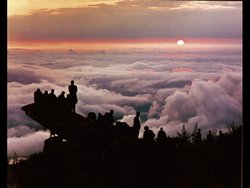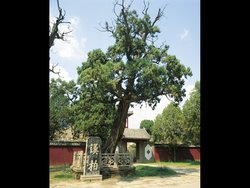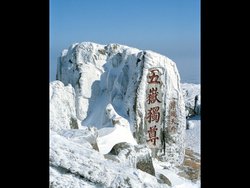Mount Taishan Scenic Beauty and Historic Interest Zone, China
Contents
- 1 Introduction
- 2 Geographical Location
- 3 Date and History of Establishment
- 4 Area
- 5 Land Tenure
- 6 Altitude
- 7 Physical Features
- 8 Climate
- 9 Vegetation
- 10 Fauna
- 11 Cultural Heritage
- 12 Visitors and Visitor Facilities
- 13 Scientific Research and Facilities
- 14 Conservation Value
- 15 Conservation Management
- 16 IUCN Management Category
- 17 Further Reading
Introduction
Mount Taishan Scenic Beauty and Historic Interest Zone (36°11'-36°31N, 116°50'-117°12'E) is a World Heritage Site located in the Shandong Province of China.
Geographical Location
Mt Taishan is located in central Shandong Province, just north of Tai'an City. Its main peak (Jade Emperor) is at 36°16'N and 117°06'E. The whole area lies at 36°11'-36°31N, 116°50'-117°12'E.
Date and History of Establishment
The mountain has been specifically protected throughout history, except in times of war and revolution. Protection measures culminated in the establishment of Mt. Taishan as a scenic beauty and historic interest zone in 1982. Inscribed on the World Heritage List in 1987.
Area

25,000 hectares (ha). The base of Mt. Taishan covers an area of 42,600 ha.
Land Tenure
State.
Altitude
Mt. Taishan rises from about 150 meters (m) above sea level to Jade Emperor Peak at 1,545 m.
Physical Features
Mt. Taishan rises abruptly from the vast plain of central Shandong, and is naturally endowed with many scenic sites. Geologically, it is a tilted fault-block mountain, higher to the south than north, and is the oldest and most important example of the paleo-metamorphic system representative of the Cambrian Period in eastern China. Referred to as the Taishan Complex, it comprises magnetized, metamorphic, sedimentary rock and an intrusive mass of various origins that were formed in the Archean Era 170-200 million years ago. Subsequently, in the Proterozoic Era, the Taishan region began to rise, becoming part of the continent by the end of the era. Uplift continued until the middle of the Cenozoic Era. The gneiss which emerged in the Taishan region is the foundation for all of North China. Cambrian strata, fully emerged in the north, are rich in fossils. Six streams flow from the summit, their water renowned for its extremely low mineral content, slight acidity (pH = 6.3) and relatively high oxygen content (6.4 milligrams per liter (mg/l).
Climate
The area falls within the warm temperate climatic zone. Meterological data are not available.
Vegetation

Vegetation covers 79.9% of the area, which is densely wooded, but information about its composition is lacking. The flora is diverse and known to comprise 989 species, of which 433 species are woody and the rest herbaceous. Medicinal plants total 462 species and include multiflower knotweed, Taishan ginseng, Chinese gromwell and sealwort, which are renowned throughout the country. Some trees are very old and famous, notably the 'Han Dynasty Cypresses' (planted 2,100 years ago by Emperor Wu Di of the Han Dynasty), 'Tang Chinese Scholartree' (planted 1,300 years ago), 'Welcoming Guest Pine' (500 years old) and 'Fifth Rank Pine' (named by Emperor Qin Shi Huang of the Qin Dynasty and replanted some 250 years ago).
Fauna
There are over 200 species of animals in addition to 122 species of birds, but precise details are lacking. Large-scaled fish Varicorhinus macrolepis is found in running water at 300-800 m. Considered a delicacy in the Qing Dynasty, it is one of the five most famous edible fishes in China.
Cultural Heritage

Mt. Taishan has an extremely rich cultural heritage and, in the words of Guo Moruo, a modern Chinese scholar, is "a partial miniature of Chinese culture". Moreover, the way in which the culture has been integrated with the natural scenery is considered to be a precious legacy. Cultural relics include memorial objects, ancient architectural complexes, stone sculptures and archaeological sites of outstanding importance. There are 22 temples, 97 ruins, 819 stone tablets, and 1,018 cliffside and stone inscriptions. Mt. Taishan is one of the birthplaces of the Chinese civilization, evidence of human activity dating back 400,000 years to Yiyuan Man of the Palaeolithic Period. By Neolithic times, 5,000-6,000 years ago, it had become a significant cultural center with two cultures flourishing, the Dawenkou to the north and the Longshan to the south of the mountain. The Spring and Autumn Period (770-476 B.C.) of the Zhou Dynasty (1100-221 B.C.) witnessed the first flare of cultural creativity with the emergence of two rival states in the area, Qi to the north and Lu to the south of the mountain. During the Warring States Period (475-221 B.C.), the state of Qi built a 500 kilometer (km) long wall as protection from possible invasion by the state of Chu. The ruins of this earliest of great walls in Chinese history are still evident.
According to the doctrine of five elements, which dates back to the Spring and Autumn Period, the east signifies birth and spring. Thus, standing at the eastern edge of the North China Plain, Mt. Taishan has always been regarded as pre-eminent among China's five sacred mountains, first officially recognized during the reign of Emperor Wu Di of the Han Dynasty (206 B.C. - A.D. 220). For over 3,000 years, Chinese emperors of various dynasties have made pilgrimages to Mt. Taishan for sacrificial and other ceremonial purposes. These activities have acquired political significance. Rock inscriptions, stone tablets and temples bear testimony to such visits. Renowned scholars, including Confucius whose home town, Qufu, is only 70 km away, have composed poetry and prose and left their calligraphy on the mountain.
Mt. Taishan was also an important center of religious activity for both Buddhism and Taoism. In 351 B.C. an eminent monk named Lang was the first to come to the mountain, and he set up the Lang and Divine Rock temples. During the Northern and Southern Dynasties (420-589 A.D.), Jade Spring Temple, God's Treasure Temple and Pervading Light Temple were built. Prime Minister Li Jiefu of the Tang Dynasty (618-907 A.D.) regarded the Divine Rock Temple as first among China's four temple wonders. Places for Taoist activities included the Temple to the Heavenly Queen Mother, Palace of Goddess Doumu, Azure Cloud Temple,Rear Rock Basin Temple and Supreme Lord of Heaven Temple. The Temple to the Heavenly Queen Mother, built before the period of the Three Kingdoms (220-280 A.D.), is the earliest while the Azure Cloud Temple is the most influential, its influence extending over more than half of China.
Visitors and Visitor Facilities
During the Ming Dynasty (1368-1644), Azure Cloud Temple received several hundred thousand worshipers annually. Details about present numbers of visitors and facilities are not available.
Scientific Research and Facilities
Since 1907 when the American geologists B. Willis and E. Blackwekler first reported on the Taishan Complex, geological studies have been underway. Archaeological excavations have been carried out at Dawenkou since its discovery in 1959. To date, 133 tombs have been excavated and over 2,100 burial objects discovered. The Ministry of Urban and Rural Construction and Environmental Protection, Beijing University and the Historical Interest Zone Administrative Committee are now collectively studying such aspects as geology, landforms, vegetation and cultural relics to provide a scientific basis for managing the area.
Conservation Value

The sacred Mount Tai has been the object of an imperial pilgrimage for nearly two thousand years, and the artistic masterpieces contained within it are in perfect harmony with the natural landscape. It has always been a source of inspiration to Chinese artists and scholars, and symbolizes ancient Chinese civilizations and beliefs.
Conservation Management
Apart from its pre-eminence as a site of cultural significance, Mt. Taishan is geologically important, it has a diverse flora and fauna, and it is famous for its majestic scenery. The Tai'an Municipal Administrative Committee of the Taishan Area of Scenic and Historic Interest Zone is responsible for both the protection and administration of the area. Legal protection is afforded to the natural and historic heritages under the state's Cultural Relics Protection Law, Forest Protection Law, Interim Regulations Concerning the Administration of Scenic Beauty and Historic Interest Zones and various local regulations and administrative decrees.
On the basis of multi-disciplinary scientific studies underway, the Ministry of Urban and Rural Construction and Environmental Protection, Beijing University and the Mt. Taishan Scenic Beauty and Historic Interest Zone Administrative Committee will jointly revise and amplify the plan to protect, manage and develop the Mt. Taishan zone in accordance with the Interim Regulations Concerning the Administration of Scenic Beauty and Historic Interest Zones issued by the State Council. The present administrative structure is to be re-adjusted, local government function strengthened, scientific and technical personnel trained, and facilities improved and expanded.
Management Constraints
Preservation and management facilities (e.g. fire control) are inadequate. Tourists inundate the area during holidays and festivals, causing some damage to scenic sites and hampering management. Some modern buildings erected in the scenic areas are incongruous with the surrounding landscape. Damage to scenic sites and quarrying for [[rock]s] by farmers is on the increase. The endemic red-scaled fish is on the verge of extinction due to inadequate water resources and poor management. Certain cultural relics, such as the Diamond Sutra in Sutra Rock Valley, are in urgent need of restoration.
Staff
The Administrative Committee of Mt. Taishan Scenic Beauty and Historic Interest Zone has a staff of over 30 professionals (undated information).
Budget
No information .
IUCN Management Category
- III (Natural Monument)
- Natural/Cultural World Heritage Site - Natural Criterion iii/Cultural Criterion iii
Further Reading
- A list of books about Mt Taishan in various dynasties is included with the Chinese World Heritage Site nomination.
| Disclaimer: This article is taken wholly from, or contains information that was originally published by, the United Nations Environment Programme-World Conservation Monitoring Centre (UNEP-WCMC). Topic editors and authors for the Encyclopedia of Earth may have edited its content or added new information. The use of information from the United Nations Environment Programme-World Conservation Monitoring Centre (UNEP-WCMC) should not be construed as support for or endorsement by that organization for any new information added by EoE personnel, or for any editing of the original content. |